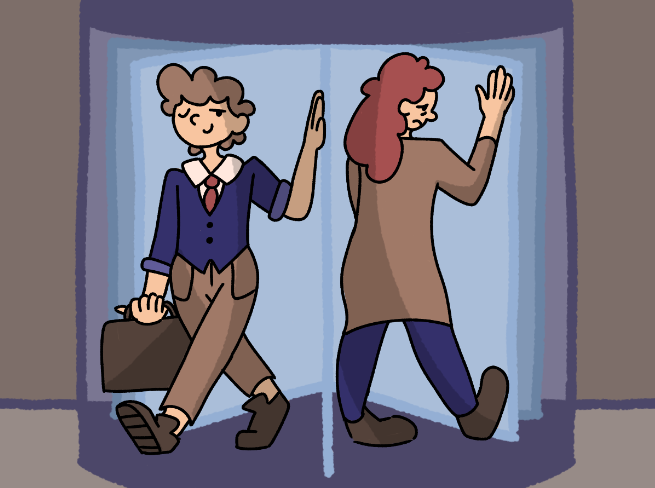There exists a widely accepted truth of modern life: the Internet is everywhere and unavoidable. As the popular saying goes, unless you “live under a rock,” it is nearly impossible to escape its digital clutches.
With its staggering upheaval of the world’s traditional methods of communication and socialization, the Internet has changed not only the lens through which we see the world but the lens through which we see each other. This is especially prevalent in the case of parasocial relationships, which have gained newfound significance in this digital age and adapted to the shifting dynamics between online users and influencers.
In the face of its increasing relevance, it becomes crucial to examine the underlying factors that have contributed to the emergence of parasocial relationships and recognize the adverse effects of unhealthy parasocialism. While promoting online safety and privacy, it is also key to emphasize the importance of healthy engagement when consuming media.
If one has participated in Internet culture in any capacity, chances are they have engaged in parasocial behavior. Coined in 1956, the term “parasocial relationship” is defined as a one-sided relationship where one person extends emotional energy, interest or time, and the other party is entirely unaware of the other’s existence. This can manifest in a myriad of ways with varying levels of intensity; by subscribing to a favorite Youtuber, labeling oneself as a Swiftie or a Belieber or developing a vested interest in the fate of a fictional character, those who consume content often feel a bond with the media or its creator and seek avenues to express their admiration and loyalty.
While these examples may sound recent, the idea of a parasocial relationship has existed long before the emergence of the Internet. For as long as public figures, such as politicians, religious figures and fictional characters have held influence, fans have invested emotional energy into their images and demonstrated one-sided interests. In 1844, for instance, the term Lisztomania was coined to describe the hysterical frenzy of the admirers surrounding Hungarian composer Franz Liszt, a level of deep obsession previously unseen before. It was with the birth of the Internet that the scope of people’s influence increased, launching the world into a brand-new level of parasocialism and redefining the nature of all relationships.
Despite the lopsided nature of parasocial relationships, studies have shown that the allure of these dynamics extends beyond the typical two-way exchange of other relationships. Researchers have found that while parasocial relationships cannot practically replace real relationships, they can be vital in fulfilling social needs and decreasing loneliness. In instances where people do not have access to social spaces, social media can serve as a useful tool to satisfy the need for human connection.
This was especially evident during the quarantine period of the COVID-19 pandemic when the desire for social interaction through digital means skyrocketed. During this period, electronic use was crucial in engaging with the social web of the world. Consequently, parasocial closeness increased over time, suggesting that certain media became more meaningful to people as they participated in social distancing and lost the ability to engage with others in person.
The role of loneliness in the development of parasocial relationships cannot be understated. Despite the growing connectivity of the global population, loneliness has only evolved into a greater issue. According to a 2019 survey, 61% of Americans reported being lonely, with an increased risk for depression, anxiety and dementia. This increase in loneliness has seen an upward trend since the 1970s, with many attributing the phenomenon to a variety of factors, including increased time spent on productivity instead of social interaction, the availability of on-demand entertainment and, paradoxically, the rise of social media.
This is where parasocialism comes in, primed to fulfill the role of a real relationship without the pressure of actually being in one. In many cases, bonds with celebrities, fictional characters or influencers can be beneficial for improving loneliness by providing a sense of companionship or community. In others, the line between the two can start to blur or dissolve altogether. In the words of Professor Kurt Gray in his book, “The Mind Club,” “Loneliness makes people imagine a loving bond with other minds, and this love can make even imaginary minds real.” It is comforting to simulate relationships and scenarios in one’s head, especially without the external fear of rejection or abandonment. Regardless of how one-sided the connection may truly be, people view even the imitation of a relationship substantially better than the total lack of one.
Parasocial relationships, however, do not come without a number of harmful consequences, with a lack of boundaries between what is real and what is parasocial leading to potentially dangerous outcomes for any party involved. While parasocialism can provide generous benefits by fulfilling social needs and increasing connectivity, it can also encourage feelings of insecurity, generate a false sense of reality, produce obsessive behaviors and lead to withdrawal from real relationships. Endless accounts of the stalking and harassment of celebrities by overzealous fans provide vivid pictures of what can happen when the connection turns destructive, an alarmingly common occurrence in the modern age.
In the same vein, some researchers have found evidence of the negative impact of parasocial relationships on the mental health of those who engage in them online. A 2019 study on the relationship between YouTube addiction, social anxiety and parasocial relationships with YouTubers found a correlation between all three factors. Among other connections, the study concluded that parasocial relationships mediate the relation between social anxiety and YouTube addiction and that social anxiety also moderates this effect. Additionally, evidence has been found to suggest that parasocial relationships and social media use may also lead to eating disorders and a decline in cognitive skills.
The reality of digitalism is that, whether ultimately beneficial or not, parasocialism is nearly impossible to completely avoid or cut out. This makes it even more imperative to emphasize the use of media literacy and self-awareness when navigating any online space. When it comes to celebrities or people we see online, it is essential to recognize that the persona they present to the Internet is curated and may not fully represent the entirety of their reality. As a result, it is important that we honor the boundaries of those online by acknowledging the distinction between their public image and their personal life. By respecting the privacy of others and maintaining the same level of security for ourselves, we can engage with media in a healthy manner and prevent damaging consequences while fostering better relationships, both online and offline.
Do you think parasocial relationships are beneficial or harmful? Let us know in the comments below.















































































